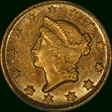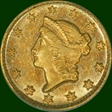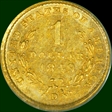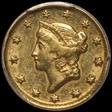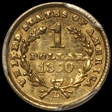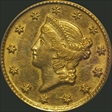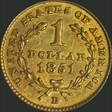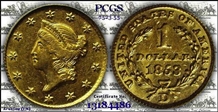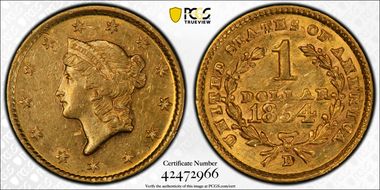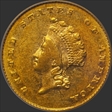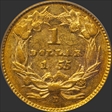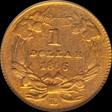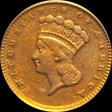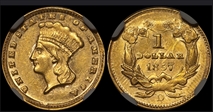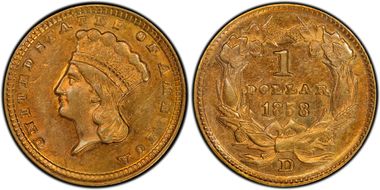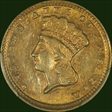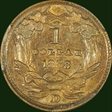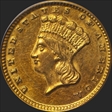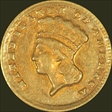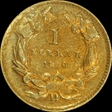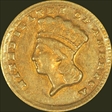Overland Trail 的钱币相册
The most common of the Dahlonega gold dollars and very popular with type collectors. Deeply and irredescently toned obverse and reverse. A spectacular example.
The most common of the Dahlonega gold dollars and very popular with type collectors. Deeply and irredescently toned obverse and reverse. A spectacular example.
The most common of the Dahlonega gold dollars and very popular with type collectors. Deeply and irredescently toned obverse and reverse. A spectacular example.
The most common of the Dahlonega gold dollars and very popular with type collectors. Deeply and irredescently toned obverse and reverse. A spectacular example.
Mintage: 9,982. Liberty Coronet. First minted in 1849, at 13mm this is the smallest of all United States coins. A conditionaly rare issue in AU55 with a total coins known in all grades of 150-175. This example has green-gold, crusty surfaces and splashes of gold toning. Some die clashing evident on reverse. One of the few U. S. issues with the date on the reverse.
Mintage: 9,982. Liberty Coronet. First minted in 1849, at 13mm this is the smallest of all United States coins. A conditionaly rare issue in AU55 with a total coins known in all grades of 150-175. This example has green-gold, crusty surfaces and splashes of gold toning. Some die clashing evident on reverse. One of the few U. S. issues with the date on the reverse.
Uncountalbe clashmarks to the left of Lady Liberty gives her a "broken nose" look. Original yellow gold and good strike withstanding, this issue is degraded by poor lustre and clashmarks. Very difficult to find nice looking 52-D'S
Nice golden toning with only slight wear on the hair above the ear and the "1" on the reverse. Stars and all devices boldly struck. A rare Dahlonega type one gold dollar
This date seems to have many coins with contact marks, dings, and mint made problems. The present piece is no exception as it has a number of dings and contact marks on the obverse, but a nice strike. The reverse has die scratches but otherwise has good strike and decent luster.
Mintage: 1,811. Indian Princess. Complaints that the gold dollar was too small caused a redesign in 1854. A collosal mistake of design by James Longacre with weak strikes of virtually all coins from all five mints. This issue has a weak 8 in the date, as with most 55's, otherwise nice detail and gold toning with some reflectiveness noted around the devices. As attractive as a 55-D can get. The rarest of all Dahlonega gold dollars. From the North Georgia Collection.
Mintage: 1,811. Indian Princess. Complaints that the gold dollar was too small caused a redesign in 1854. A collosal mistake of design by James Longacre with weak strikes of virtually all coins from all five mints. This issue has a weak 8 in the date, as with most 55's, otherwise nice detail and gold toning with some reflectiveness noted around the devices. As attractive as a 55-D can get. The rarest of all Dahlonega gold dollars. From the North Georgia Collection.
The 56-D creation is the third rarest coin behind the 55-D and 61-D. This piece has smooth overall wear with nice gold toning. The U in United is weak, as usual, but the date is complete with slight weakness. Eye appeal can be difficult with the issue but is nice for this specimen.
The 56-D creation is the third rarest coin behind the 55-D and 61-D. This piece has smooth overall wear with nice gold toning. The U in United is weak, as usual, but the date is complete with slight weakness. Eye appeal can be difficult with the issue but is nice for this specimen.
1858-D G$1 MS61 PCGS. Variety 10-M. A single die pair is known for the scant mintage of 3,477 pieces. The present example has peach-gold toning around design elements while the high points and open fields are gunmetal-blue. No marks are visible, though a J-shaped strike-though, as made and often seen on the issue, is near the ED in UNITED. The strike is above average for a Dahlonega emission, with blending evident on the 5 in the date and the leaf above the right ribbon end. The reverse displays a triple set of clash marks from Liberty's profile
1858-D G$1 MS61 PCGS. Variety 10-M. A single die pair is known for the scant mintage of 3,477 pieces. The present example has peach-gold toning around design elements while the high points and open fields are gunmetal-blue. No marks are visible, though a J-shaped strike-though, as made and often seen on the issue, is near the ED in UNITED. The strike is above average for a Dahlonega emission, with blending evident on the 5 in the date and the leaf above the right ribbon end. The reverse displays a triple set of clash marks from Liberty's profile
1858-D G$1 MS61 PCGS. Variety 10-M. A single die pair is known for the scant mintage of 3,477 pieces. The present example has peach-gold toning around design elements while the high points and open fields are gunmetal-blue. No marks are visible, though a J-shaped strike-though, as made and often seen on the issue, is near the ED in UNITED. The strike is above average for a Dahlonega emission, with blending evident on the 5 in the date and the leaf above the right ribbon end. The reverse displays a triple set of clash marks from Liberty's profile
Mintage: 4,952. Indian Princess (Large Head) The design blunder by Longacre brought about the immediate redesign of the gold dollar once again in 1856. An improvement, but incomplete strikes still evident at branch mints. This example has bright yellow golden toning with only trace of wear. Near full strike, nice frosty luster, and eye appeal. A rare issue in AU58. Total coins known 150-175.
Mintage: 4,952. Indian Princess (Large Head) The design blunder by Longacre brought about the immediate redesign of the gold dollar once again in 1856. An improvement, but incomplete strikes still evident at branch mints. This example has bright yellow golden toning with only trace of wear. Near full strike, nice frosty luster, and eye appeal. A rare issue in AU58. Total coins known 150-175.
The gold CAC sticker carried on this first generation PCGS holder is suggestive of a higher grade than the XL40 indicated. The coin has beautiful original copper coloration on both obverse and reverse as well as a pretty decent strike for this issue. With a mintage of less than 2000 it is one of the rarest gold dollar made.
The gold CAC sticker carried on this first generation PCGS holder is suggestive of a higher grade than the XL40 indicated. The coin has beautiful original copper coloration on both obverse and reverse as well as a pretty decent strike for this issue. With a mintage of less than 2000 it is one of the rarest gold dollar made.
The gold CAC sticker carried on this first generation PCGS holder is suggestive of a higher grade than the XL40 indicated. The coin has beautiful original copper coloration on both obverse and reverse as well as a pretty decent strike for this issue. With a mintage of less than 2000 it is one of the rarest gold dollar made.




















